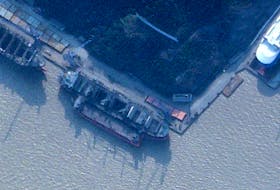Media reports stating that an American explorer spotted a plastic bag lying on the floor of the world’s deepest ocean floor may or may not be true, according to a spokeswoman for people who actually visited the ocean floor.
Several media outlets, including the National Geographic and the BBC , reported that an American explorer, Victor Vescovo, spotted a plastic bag and candy wrappers during a record-breaking submarine dive into the Mariana Trench, hailed as the world’s deepest oceanic pocket.
However, Stephanie Fitzeherbert, a spokeswoman for Vescovo’s team says that can’t be confirmed. “No candy wrappers,” she wrote in an email. She did confirm that whatever Vescovo found at the bottom of the ocean floor is “something that resembled man made waste” but could not say whether it was a plastic bag.
Vescovo, a former navy officer, spotted the man-made waste after descending 10,927 metres into the deep oceanic pocket, according a press statement released on Monday. While the statement included details of the voyage, which included four dives into the deep-sea trench over the course of three weeks, beginning in April, it did not make any mention of the waste discovered on the floor.

Video clips by the Atlantic Production of Vescovo landing on ocean soil do point out an unidentified object in an otherwise barren-looking floor. The object is small and triangular shape and appears to share the same colour as the ground.
The waste was never retrieved so it’s hard to ever know whether it was indeed a plastic bag. Yet the discovery still points out a notable, if troubling aspect of the conditions of the world oceans.
Researches in 2018 combed through a database of photos and videos from previous dives found evidence the deepest-known waste — a plastic bag — in the Mariana Trench, according to a study released the same year. Of all the debris found in the database, plastic was found as the most prevalent type of rubbish.
A study released in February 2019, tested amphipods from six deep-sea trenches and all were found ingesting microplastics.
The team discovered a variety of new species through their underwater experiences and collected samples. According to the CNN, the expedition team stated that they plan to test these samples to check how much plastic gets ingested.
Vescovo’s dive was the first out of four dives carried out in the deep-sea pocket, known as Challenger Deep, over three weeks, starting in late April. Previously, the deepest dive totaled over 10,912 metres and was carried out by U.S. Navy lieutenant Don Walsh and Swish engineer Jacques Piccard in 1960.
Movie director James Cameron attempted a solo plunge in 2012, after creating his own submarine, known as Deepsea Challenger, and reached a depth of 10,908 metres.
Vescovo’s expedition into the Mariana Trench also marks his fourth ocean bottom visit, with a fifth to go — the Molly Deep in the Arctic Ocean, the shallowest of the five at a mere 5,669 metres.
“We feel like we have just created, validated and opened a powerful door to discover and visit any place, any time, in the ocean — which is 90 percent unexplored,” said Vescovo.

Copyright Postmedia Network Inc., 2019








